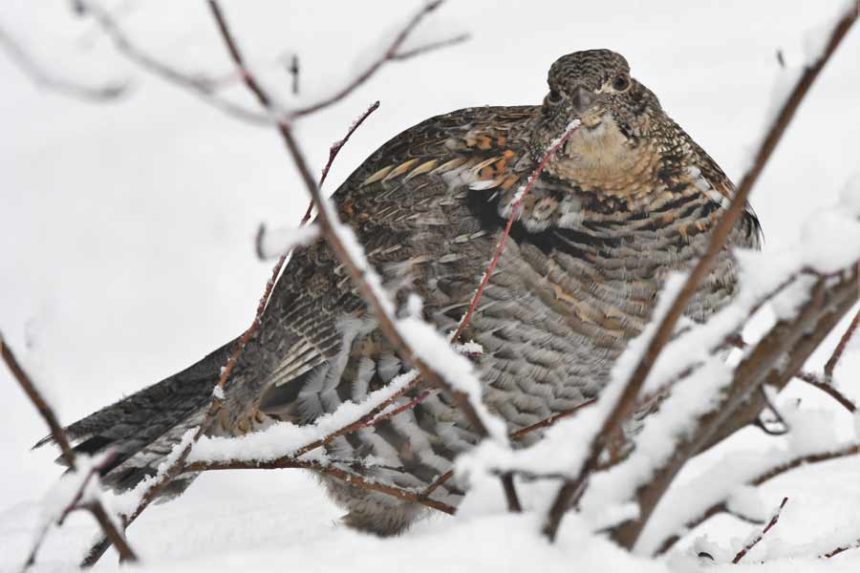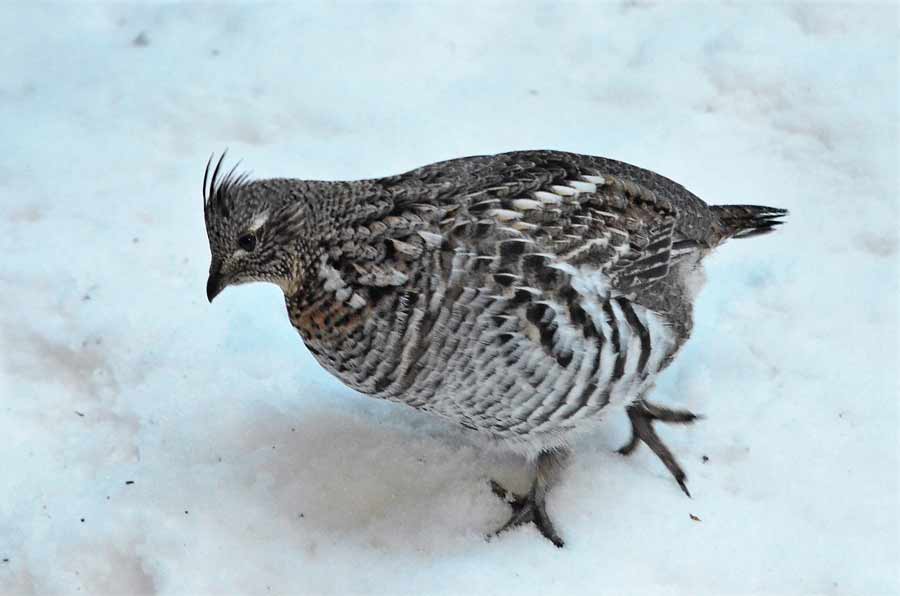How ruffed grouse survive the cold in Island Park
Published at
Last week, I watched a male ruffed grouse wiggle out of a snow cave created from the lower branches of large spruce in Island Park. It was looking for brunch; walking over to a frozen serviceberry bush, he started nipping off twigs from the bush and relishing the few dried berries still hanging on.
As I watched him walk from branch to branch, my thoughts went to an experience from years ago. My dad and I were snowshoeing across a mountain meadow in Teton Valley, when we were startled by a ruffed grouse flying out of the snow within two feet of us. For a moment, I thought that I was a goner.
Upon further examination, we found that the bird had dove into the powdery snow and had burrowed through the snow to where it had flushed from. We also noticed that the meadow was dented with holes from other grouse protecting themselves by flying into the air, then diving into the snow.
Once under the snow, the grouse burrow up to 12 feet about a foot under the snow by using their wings and feet in a process called “snow perching.” Even with the outside temperatures down to minus 20 degrees, they are insulated at 32 degrees for a nice comfortable night.
The bird that I watched eat the buds and berries would snap off twigs up to four inches long and then break them into small bites and swallow them. Ruffed grouse have two pockets in front of their stomach, called a “crop” where pieces of branches and buds are stored. After these pieces of fibrous material pass through the stomach, they enter the gizzard where it is ground up by small stones. With this digestive system, they can eat and digest bitter, toxic cellulose that other birds cannot.
Another adaptation that these birds have to help them to live during a bitter cold winter, is feet projections on their toes. These projections act almost like snowshoes, allowing them to walk on the top of deep snow.

Adult males stake out a territory of about five to six acres once they reach breeding age and defend it vigorously from other males. He marks that territory by standing on a log, rock or mound of dirt and does a “booming” or a “drumming” ritual by flapping his wings with rapid wing beats. The rapid movement of the wings creates a vacuum under its wings which causes small explosions similar to thunder during thunderstorms. This booming or drumming happens all year long but is increased in the spring during their breeding time. The booming can be heard for about a quarter of a mile and is a warning to other males to stay away.
Usually, one or two hens will also make that same territory their home but the males and females do not form a bond between each other and he does not help raise the chicks. In fact, after the chicks are hatched and are dry, they feed themselves by eating protein-rich bugs. Then within five days they can fly up to a hundred yards. I have never seen them before they are a few weeks old, but as babies they are the size of a man’s thumb and have been described as “large bumble bees” when they fly.
A hen may hatch up to 14 eggs and she usually stays with the chicks until the late summer when all of them go out on their own. They do not gather in groups except during the winter when they may find an area rich with food which will cause them to become a loose group to utilize the abundant food source. Some of them may find a cabin where there is a bird feeder and feed there, but their digestive system may not be equipped to digest that food. Recently, I watched a group of six ruffies feeding under a bird feeder, but I also observed them eating buds and twigs from bushes near the feeders.
If you like to cross country ski or snowshoe off the groomed trails where there are a lot of ruffed grouse, you may have one explode out of the snow from its snow-perch. You will never forget it. You may even think that you have awakened a grizzly bear from its winter nap.


Living the Wild Life is brought to you by The Healing Sanctuary.


